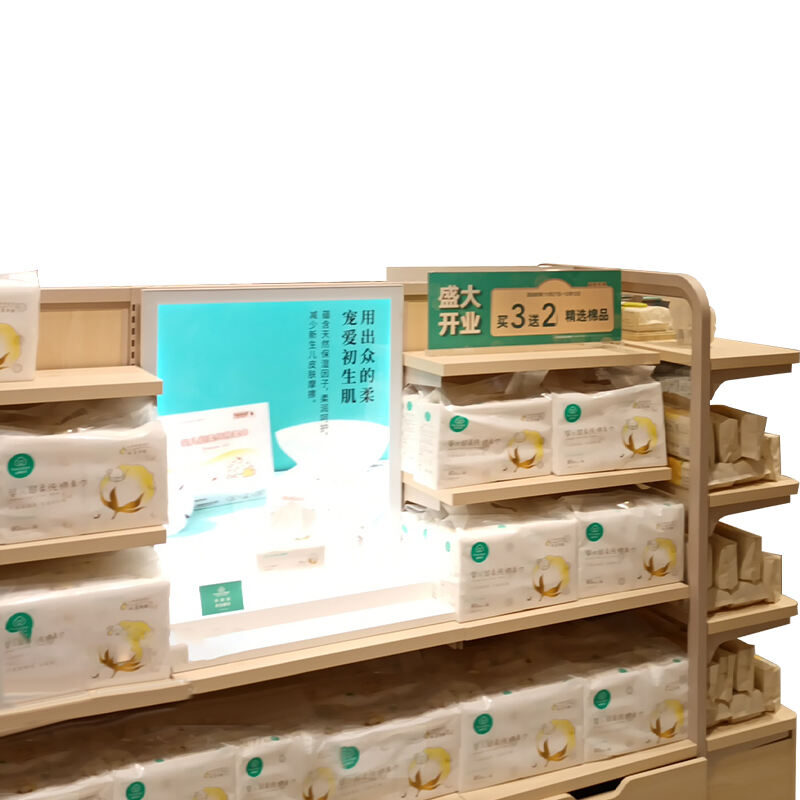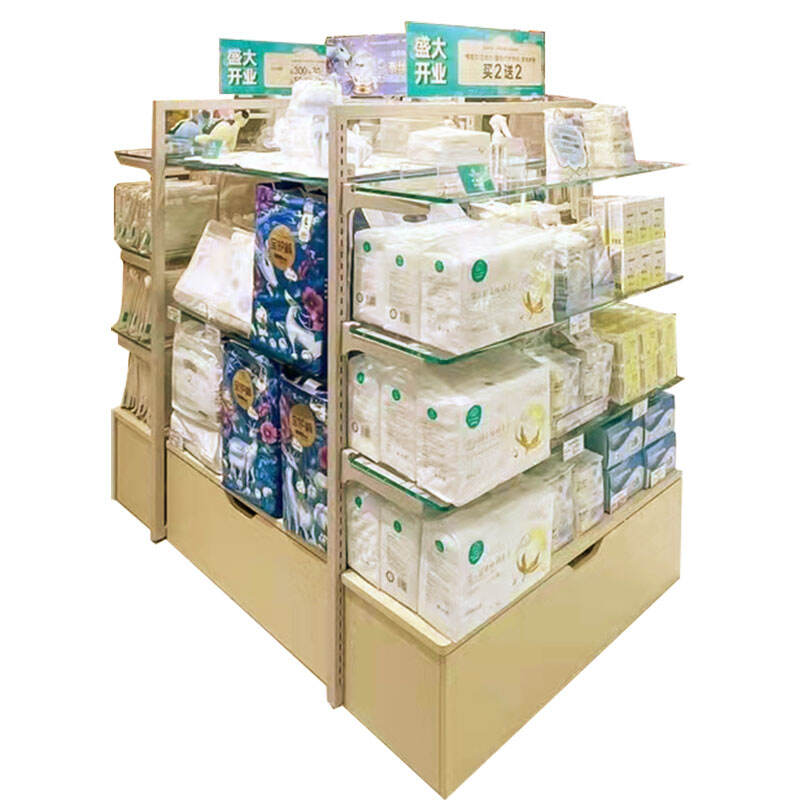معايير الاختيار الرئيسية للمتجر منصات العرض
تقييم أبعاد المنتجات وقدرة التحمل
يعني اختيار الرفوف المعروضة في المتجر بشكل الصحيح النظر إلى شيئين رئيسيين: ما هي أحجام المنتجات التي سيتم وضعها عليها وعلى أي وزن يجب أن تكون قادرة على تحمله. لا يرغب أحد في حدوث انهيار أمام الزبائن، لذا يجب على الرفوف بالتأكيد دعم أي منتجات موضوعة عليها. في الغالب، تحدد الشركات المصنعة حدًا أقصى للوزن يتراوح بين 50 رطلاً للرفوف الصغيرة وحتى أكثر من 200 رطل لتلك النماذج الصناعية الكبيرة المستخدمة في المستودعات أو المتاجر الكبيرة. من المهم أيضًا التأكد من أن المنتجات تناسب الرف بشكل مناسب. يؤدي عدم التوافق هنا إلى هدر مساحة قيمة في المتجر ويجعل العرض مرتبكًا بدلًا من أن يكون جذابًا. فكّر أيضًا في كيفية تكديس العناصر معًا – بعض الرفوف تعمل بشكل أفضل مع أشكال معينة مقارنة بغيرها. إن تخصيص الوقت للتحقق من هذه التفاصيل يساعد التجار على اختيار رفوف تحافظ على الأمان مع خلق تجربة تسوق جذابة للعملاء الذين يسيرون في الممرات.
مطابقة نوع الحامل مع فئة المنتجات
يُعد اختيار الحامل الصحيح أمرًا مهمًا للغاية عند محاولة عرض المنتجات المختلفة بشكل فعّال. بعض السلع تبدو أفضل على أنواع محددة من الأرفف. خذ على سبيل المثال الملابس، فهي تبدو رائعة على الرفوف الرأسية التي تسمح للعملاء برؤية ما هو متوفر بسهولة دون الحاجة للانحناء أو التمدد كثيرًا. أما الإلكترونيات فلها قصة مختلفة تمامًا. عادةً ما تحتاج إلى ترتيب رفوف يسمح بوضع أجهزة متعددة معًا مع بقاء كل جهاز ملفت للنظر. يجب على تجار التجزئة أن يفكروا في هوية عملائهم وما يجذب انتباههم قبل اتخاذ قرار بشأن خيارات العرض. عندما يتطابق الحامل الصحيح مع المنتج المعروض، فإن المتاجر تنجح في إنشاء عروض تجذب الانتباه أولًا وتحتفظ باهتمام العملاء بما يكفي لدفعهم لشراء المنتجات.
توحيد العلامة التجارية من خلال خيارات المواد (الخشب/المعدن/الأكريليك)
إن اختيار المواد المناسبة لأركان العرض يلعب دوراً كبيراً في إبراز شخصية العلامة التجارية وإتمام المهمة على أكمل وجه. غالباً ما تختار العلامات الفاخرة الخشب أو الزجاج كمواد لصناعة أركان عرضها، لأن هذه المواد تعكس الأناقة والرقي. في المقابل، تميل العلامات العصرية إلى استخدام المعادن أو الأكريليك لأنها تعطي مظهراً نظيفاً وحديثاً. كما أن المتانة تُعدّ عاملاً مهماً، خاصة في المتاجر المزدحمة حيث يتعرض الأشخاص باستمرار إلى الاصطدام بالأركان والمعروضات. وكمثال على ذلك، كان على سلسلة متاجر قهوة اعتمدناها في مشروعنا اختيار مواد متينة للغاية لصناعة طاولات العرض لديها، بعد أن لاحظت مشاكل في المتاجر الأخرى بسبب أركان العرض التالفة. وبالإضافة إلى ذلك، فإن الاهتمام بالمواد الصديقة للبيئة لم يعد فقط أمراً مفيداً للعالم، بل أصبح جزءاً من توقعات العملاء من الشركات المسؤولة. عندما تتماشى اختيارات الشركات للمواد مع قيم العلامة التجارية ومدة التحمل المطلوبة لأركان العرض، فإنها تبقى وفية لطابعها بينما تتماشى في الوقت نفسه مع توجهات المستهلكين الحاليين.
تحسين وظائف أركان العرض
مزايا التنقّل لتخطيط مرِن لمتاجر البيع
يجعل إضافة العجلات أو البكرات إلى منصات العرض أكثر قدرة على الحركة، مما يساعد المتاجر على الحفاظ على مرونة في تخطيطها. فهذا يجعل من السهل نقل منصات العرض، وهو أمر مفيد بشكل خاص عند إعداد مبيعات الأعياد أو تجديد مظهر المتجر كل بضعة أشهر. كما يمكن لبعض المنصات أن تطوى أو تنكمش بالكامل، مما يعني أنها تشغل مساحة أقل عندما لا تكون مطلوبة، وهو أمر مهم خاصة في الفترات الأقل ازدحامًا. ولكن قبل التركيز الكامل على ميزات الحركة، يجب على التُّجار التحقق من مدى استقرار هذه المنصات فعليًا. فليس من المرغوب فيه أن تنقلب المنصات وتتسبب في حوادث للعملاء أو تلحق الضرر بالمنتجات. يجب أن تكون السلامة دائمًا في المقام الأول، حتى لو استدعى الأمر التخلي عن بعض عوامل الراحة.
تعزيز الرؤية من خلال التصاميم المُرَتَّبة
تعمل العروض المتدرجة بشكل جيد للغاية لجعل ترتيبات المنتجات تبدو أكثر جاذبية ومساعدة الأشخاص على رؤية ما هو معروض. عندما تلعب المتاجر بارتفاعات مختلفة في إعداداتها، فإن ذلك يجذب بشكل طبيعي نظر العملاء إلى الأعلى حيث قد يلاحظون أشياء كانت ستفوتهم في حال لم تُعرض بهذه الطريقة. للحصول على أفضل استفادة من هذه العروض، من المهم دراسة سلوك المتسوقين داخل المتاجر. يجد بعض البائعين أن بعض المنتجات تُباع بشكل أفضل عندما توضع على ارتفاعات معينة تعتمد على نوع المنتج. الفكرة الأساسية هنا بسيطة: إذا كانت المنتجات أسهل في الرؤية والوصول، فإن العملاء سيتفاعلون معها بشكل متكرر أكثر. ولذلك يخصص العديد من البائعين الناجحين وقتًا لدراسة هذه التفاصيل قبل إعداد الرفوف.
مراعاة سهولة الوصول أثناء إعادة التخزين
عند تصميم منصات العرض، فإن التركيز على سهولة الوصول لإعادة التخزين يُحدث فرقاً كبيراً في إدارة المخزون بشكل فعال. تصميم المنصات الجيد يسمح للطاقم بالتقاط العناصر بسرعة أثناء إعادة التخزين، في حين يستمر المتسوقون في تصفح المنتجات دون عرقلتهم، مما يقلل من تلك المقاطعات المزعجة التي واجهناها جميعاً. لقد بدأت بعض المتاجر باستخدام ألواح خلفية مفتوحة أو أدراج منزلقة خلف المنصات بحيث يمكن للعاملين إعادة التخزين بشكل غير ملحوظ دون إحداث ازدحامات مرورية بالقرب من المنتجات الشهيرة. عادةً ما تُبقي المتاجر التي تنتبه لهذه التفاصيل رفوفها ممتلئة على مدار اليوم، مما يعني عملاءً أكثر سعادة لا يواجهون أماكن فارغة عندما يريدون شيئاً محدداً.
استراتيجيات وضع مواقع استراتيجية
تنفيذ مناطق ذات حركة مرور عالية
وضعية منصات العرض في الأماكن التي يمر منها الناس بشكل طبيعي تُحدث فرقاً كبيراً في جذب الانتباه إلى المنتجات. ابدأ بدراسة تخطيط المتاجر وتحديد الأماكن التي تشهد أعلى معدلات مرور. من الأماكن الجيدة للبدء ما يقع بالقرب من المداخل أو نقاط الدفع حيث يميل العملاء إلى التوقف. تساعد أدوات التحليل على تتبع المسارات التي يسلكها العملاء ومدة تواجدهم في كل مكان، مما يسمح بوضع منصات العرض في المواضع التي يُتوقع أن تلفت النظر إليها. كما يجب مراقبة أرقام المبيعات الصادرة عن تلك مناطق العرض. إذا لم تُحقِّق بعض العناصر مبيعات جيدة رغم وجودها في مواقع جيدة، فقد يكون من الضروري إجراء تعديلات. أحياناً، يُحدث نقل المنصة مسافة قصيرة فرقاً كبيراً في مدى ظهور المنتجات وعدمه.
تقنيات تجميع المنتجات التكميلية
يُعدّ تجميع العناصر التي تتلاءم جيدًا مع بعضها أمرًا مفيدًا للغاية لتحفيز البيع المتبادل. عندما تجمع المتاجر بين المنتجات المرتبطة ببعضها أو تُعدّ نُصُبًا حول مواضيع معيّنة، فإنها تخلق شيئًا جذابًا بصريًا يجذب المتسوّقين ويدفعهم لشراء المزيد. يحتاج الموظفون أيضًا إلى تدريب مناسب. يمكن للعاملين الذين يفهمون جيدًا أي المنتجات تتناسب بشكل أفضل مع بعضها البعض أن يقترحوا ترقيات أو عناصر إضافية عندما يتصفح العملاء المنتجات. في النهاية، يحصل العملاء على تجربة تسوق أفضل، كما تحقّق الشركات أرقام مبيعات أعلى، ويُفضّل العملاء العودة مرارًا وتكرارًا لأنهم يتذكرون الخدمة الجيدة والتجميع المريح للمنتجات.
دمج الإضاءة لتحقيق أقصى تأثير
تُحدث الإضاءة الديناميكية فرقًا كبيرًا عندما يتعلق الأمر بجذب الانتباه إلى المنتجات داخل المتاجر. وضع تلك المصابيح المركزة بشكل دقيق أو إضافة شرائط LED حول النُصُب يُغيّر تمامًا الطريقة التي ينظر بها العملاء إلى المعروضات. منتجات فجأة تبدو أفضل، وجذب الانتباه بسهولة أكبر. غالباً ما يتحدث البائعون عن خلق جو خاص تظهر فيه بعض العناصر بشكل لافت على الرفوف. هل ترغب في معرفة ما إذا كانت هذه الحيل الإضاءة فعالة بالفعل؟ تقوم العديد من الشركات بإجراء اختبارات مقارنة بين الإعدادات المختلفة جنباً إلى جنب. تُظهر هذه التجارب بدقة أي المصابيح تجعل الناس ينظرون إلى المنتجات لفترة أطول. بناءً على ما يتم اكتشافه، يقوم مديرو المتاجر بتعديل استراتيجيات الإضاءة الخاصة بهم حتى تبدأ أرقام المبيعات في الارتفاع.
الأخطاء الشائعة في تنفيذ منصات العرض
إغراق منصات العرض بالبضائع
عندما تقوم المتاجر بتجميع الكثير من البضائع على منصات العرض الخاصة بها، فإن هذا يجعل المظهر العام أسوأ بدلاً من أن يكون أفضل. يحتاج التُّجار إلى اختيار المنتجات المناسبة لكل مساحة وعدم ملء كل إنش ببضائع. اختيار عدد أقل من العناصر يسمح للعناصر الجيدة بالبروز وجذب انتباه المارة. كما أن مراقبة ردود فعل العملاء تعطي مؤشرات حول المسافات المثالية بين المنتجات، بحيث لا تشعر بالازدحام، ولا تكون فارغة تمامًا. تحقيق هذا التوازن يساعد المتاجر على إنشاء منصات عرض مريحة ومرحبة، وفي الوقت نفسه تجذب انتباه المارة.
إهمال الاتساق في الهوية البصرية للعلامة التجارية
عندما يتعلق الأمر بتجارة البصريات الجيدة، فإن الحفاظ على مظهر موحد عبر جميع منصات العرض الخاصة بنا يُعد أمرًا مهمًا للغاية. وعندما تتماشى تلك المنصات مع ألوان العلامة التجارية والطراز التصميمي العام، يحظى المتسوقون بتجربة أفضل بكثير أثناء تجولهم في المتاجر. ولكن إذا بدأت منصات العرض تختلف في الشكل، فسوف يشعر الأشخاص بالارتباك حيال المقصود الحقيقي لعلامتنا التجارية. لقد شهدنا حدوث هذا من قبل، حيث أدت الرسائل المختلطة مباشرةً إلى انخفاض المبيعات. كما يجب على المتاجر أن تقوم أيضًا بمراجعة منصات العرض الخاصة بها بانتظام، ربما مرة كل بضعة أشهر؟ وبهذه الطريقة يمكننا اكتشاف أي تباينات في وقت مبكر والحيلولة دون حدوث الفوضى والحفاظ على هوية علامتنا التجارية.
الإقلال من تقدير احتياجات العرض الموسمية
يجب على المتاجر أن تواصل تغيير معروضاتها وفقًا للفصول والمناسبات إذا أرادت من العملاء أن ينتبهوا إليها على الإطلاق. يراقب أصحاب المتاجر الذكية ما يُباع متى، ويعيدون تنظيم طريقة عرض المنتجات في المتجر. على سبيل المثال، في موسم العودة إلى المدرسة، قد تُعطى الأولوية لمستلزمات التعليم بينما تُنقل المنتجات الصيفية إلى الخلف. ويساعد إعداد نوع من الجدول الزمني المتاجر على التقدم بخطوات أمام المنحنى بدلاً من التصرف في اللحظة الأخيرة. عندما يخطط تجار التجزئة مسبقًا استنادًا إلى الخبرات السابقة والظروف السوقية الحالية، فإنهم يخلقون معروضات تتفاعل فعليًا مع الأشخاص الذين يتسوقون في متاجرهم يومًا بعد يوم.

الصيانة والقيمة طويلة الأمد
بروتوكولات التنظيف لمختلف المواد
تلعب routines التنظيف الجيدة دوراً كبيراً في الحفاظ على مظهر وحدات العرض وجعلها تدوم لفترة أطول مما كانت ستكون عليه. تحتاج الأخشاب والمعادن وتلك الوحدات المصنوعة من الأكريليك الشفاف إلى معاملات مختلفة إذا أردنا أن تبقى في حالة جيدة عاماً بعد عام. وضع خطة تنظيف دورية يضمن بقاء كل شيء في حالة مقبولة وفعلياً آمنة للعملاء للتفاعل معها. تسجيل الخطوات بدقة في دليل للموظفين يساعد في تدريب الموظفين الجدد بشكل صحيح ويوفر فهماً مشتركاً لمعايير الصيانة بين الجميع. عندما نلتزم بهذه الخطوات الأساسية، تواصل وحدات العرض القيام بما يُفترض بها أن تفعله على أفضل وجه، وهو عرض المنتج الموجود عليها في أي لحظة.
تحديث مكونات العرض القابلة للتغيير
تقل تأثيرات منصات العرض بمرور الوقت إذا بقيت دون تغيير، لذا فإن استبدال الأجزاء القابلة للتعديل يحقق جدوى مالية وعملية. إن معظم منصات العرض الحديثة مُصممة بُنيوياً لتكون قابلة للتعديل، مما يعني أن الشركات يمكنها تعديل أجزاء محددة هنا وهناك بدلاً من التخلص من المنصة بالكامل عندما تخرج من الأزياء الرائجة. إن استقاء آراء العملاء الفعلية يُظهر لنا ما يجب إصلاحه أو إضافته بدقة لتعزيز فعالية منصات العرض ومظهرها. إن التعديلات الدورية تبقي الأمور تبدو حديثة مع التأكد من أن المنصات لا تزال تلبي رغبات الجمهور. عادةً ما يلاحظ التجار الذين يتابعون هذه التحديثات عن كثب تدفقاً أفضل للحركة داخل المتاجر وعملاء أكثر سعادة على المدى الطويل.
تحليل التكلفة: الاستثمار الأولي مقابل القيمة مدى الحياة
الدخول في تفاصيل تحليل التكاليف يُعد أمراً مهماً حقاً عند محاولة معرفة نوع العائد الذي نحصل عليه من منصات العرض. إن النظر إلى عوامل مثل مدة التحمل، والمظهر الجذاب، وقدرة المنصات على التكيّف مع استخدامات مختلفة، يساعد الشركات على تحديد ما إذا كانت أموالها تُنفق بشكل جيد على هذه المنصات. عندما تخصص الشركات وقتاً لتقييم التكاليف مقابل الفوائد، فإنها تبدأ برؤية القيمة الحقيقية على مدى سنوات وليس فقط في حدث واحد. على سبيل المثال، استثمرت شركة X إضافية في مواد ذات جودة عالية، وحققت ضعف عدد الزوار في المعارض مقارنة بالبدائل الأرخص. تُظهر أمثلة واقعية مثل هذه لماذا إن الإنفاق الذكي على تركيبات العرض يعزز فعلياً أرقام المبيعات ويحسّن من نظرة العملاء للعلامة التجارية في السوق.
قسم الأسئلة الشائعة
ما العوامل التي يجب أن أأخذها بعين الاعتبار عند اختيار منصات عرض المتجر؟
اخذ الأبعاد والوزن الأقصى للمنتج بعين الاعتبار، وملاءمة نوع المنصة لفئة البضائع، وخيارات المواد المستخدمة بما يتماشى مع هوية العلامة التجارية، وميزات الحركة والنقل لتسهيل التخطيطات المرنة.
كيف يمكن للكاونترات الترويجية أن تُحسّن من وظائف المتجر؟
دمج ميزات التنقّل لتسهيل تخطيط المواقع بشكل مرن، و Designs متدرّجة لتعزيز الرؤية، وسهولة الوصول لإعادة التخزين لضمان إدارة فعّالة للمخزون.
ما هي الأخطاء الشائعة في تنفيذ الكاونترات الترويجية؟
تجنّب إزدحام البضائع، وإهمال الاتساق الجمالي للعلامة التجارية، وتقدير احتياجات العروض الموسمية بشكل غير كافٍ.
كيف يمكنني الحفاظ على القيمة طويلة المدى للكاونترات الترويجية؟
تطبيق بروتوكولات تنظيف دورية، وترقية المكونات القابلة للتغيير، وإجراء تحليل التكاليف لضمان المتانة، والملاءمة، وفعاليّة العائد على الاستثمار.




